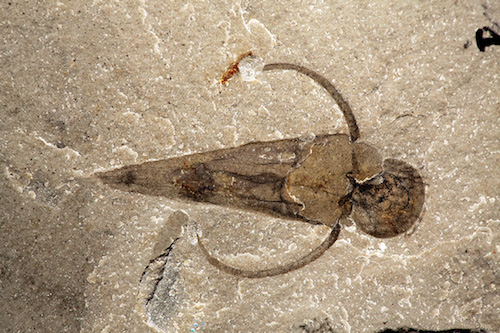 Evolution
Evolution
Newly Classified Cambrian Creature Underlines the Mystery of Living Fossils

Science Daily reports somewhat breathlessly: “Paleontologists classify mysterious ancient cone-shaped sea creatures.”
One branch on the tree of life is a bit more crowded today. A team of scientists led by 20-year-old University of Toronto (U of T) undergraduate student Joseph Moysiuk has finally determined what a bizarre group of extinct cone-shaped animals actually are.
Known as hyoliths, these marine creatures evolved over 530 million years ago during the Cambrian period and are among the first animals known to have produced mineralized external skeletons.
Long believed to belong to the same family as snails, squid and other molluscs, a study published today in the scientific journal Nature shows that hyoliths are instead more closely related to brachiopods — a group of animals which has a rich fossil record, although few living species remain today.
Brachiopods have a soft body enclosed between upper and lower shells (valves), unlike the left and right arrangement of valves in bivalve molluscs. Brachiopods open their valves at the front when feeding, but otherwise keep them closed to protect their feeding apparatus and other body parts.
Although the skeletal remains of hyoliths are abundant in the fossil record, key diagnostic aspects of their soft-anatomy remained critically absent until now.
In a nutshell, the study in Nature (“Hyoliths are Palaeozoic lophophorates“) finds that hyoliths are more like brachiopods than molluscs. Fine. Hyoliths are common Paleozoic fossils and they are very well known. They went extinct at the end of the Paleozoic. Many geology students taking a basic paleontology class will learn a bit about hyoliths.
It’s not a new idea, though, that hyoliths might be closely similar and related to brachiopods. Here’s an article citing a source that goes back well over a century, to 1901.
But then other scientists have found that hyoliths are more similar to gastropods, cephalopods (molluscs), annelids, or are of unknown affinity. What this tells you is that hyoliths are probably weird mosaics that don’t fit neatly into any one place in the big animal evolutionary tree. It also tells you these are old debates that probably won’t be settled by this Nature paper.
And so what, anyway, if hyoliths are more similar to brachiopods than to molluscs? At best this is the old cladistics line that if Group A has some but not all the features of Group B, then Group A must be ancestral to Group B. That’s all the reasoning they’ve got — and it would ignore all the differences between Group A and B and the fact that there are no intermediates between A and B.
But the big problem for any evolutionary scheme connecting Cambrian hyoliths to Cambrian brachiopods is that very modern looking brachiopods are already known from the Cambrian explosion.
The Science Daily article makes a big deal about how hyoliths from the Burgess Shale show some features similar to brachiopods:
Examination of the orientation of the helens in multiple hyolith specimens from the Burgess Shale suggests that these spines may have been used like stilts to lift the body of the animal above the sediment, elevating the feeding apparatus to enhance feeding.
…
“Resolving the debate over the hyoliths adds to our understanding of the Cambrian Explosion, the period of rapid evolutionary development when most major animal groups emerge in the fossil record,” said [co-author Martin] Smith, who started this research at the University of Cambridge and who is now a lecturer in paleontology at Durham University. “Our study reiterates the importance of soft tissue preservation from Burgess Shale-type deposits in illuminating the evolutionary history of creatures about which we still know very little.”
The authors want to think that these Burgess Shale hyoliths help in “illuminating the evolutionary history” of brachiopods. But, again, the problem is that we know for a fact that there are totally modern looking brachiopods in the Burgess Shale itself. These fossils look so much like modern brachiopods that it is easy to tell that there were true brachiopods in the Burgess Shale. You don’t have to be an expert to see this.
So what does it all mean? Brachiopods are an amazing example of a living fossil — showing remarkable and dramatic stasis, not evolutionary change. Finding that some Burgess Shale hyoliths have some similarities to brachiopods hardly changes that fact.
For a discussion of such living fossils and what they mean for evolution, see here.
Photo: Haplophrentis, courtesy of Stanley Glacier, via University of Toronto.
